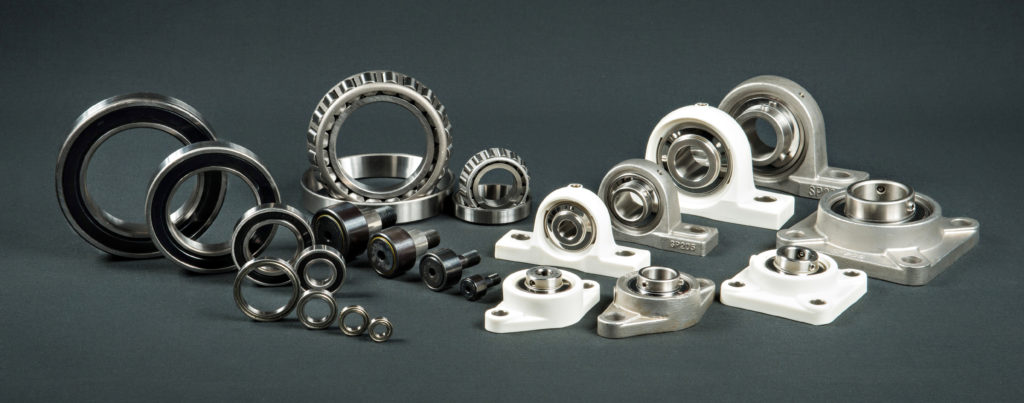Blog
How Different Bearing Materials Can Impact Usage

Bearings are essential to manufacturing and are used in many different types of equipment and machinery. From basic industrial equipment to complex machinery, bearings reduce friction and make it possible to handle different types of loads. Therefore, the use of quality and reliable materials is vital to the bearing manufacturing process.
Different materials are used to produce various types of quality bearings and their many components. These materials undergo specific processes to achieve the desired properties, improving both bearing lifespan and performance. The team at Consolidated Bearings is available to discuss the different materials used in the manufacturing of bearings, as well as, how each material affects bearing usage, integrity, and functionality.
1. Chrome Steel
Chrome steel (SAE 52100) is the most common material used to manufacture precision ball bearings, roller bearings, and tapered roller bearings. Specifically, it is used to make the load-carrying components of bearings such as inner and outer rings, balls and rollers. Chrome steel is primarily composed of carbon and has a 1.5 percent chromium content.
Chrome steel undergoes controlled processing and heat-treating methods to make the bearings sturdy and resistant to cracking. These processes enable the bearings and their components to develop surface hardness ranging from 60 to 64 on the Rockwell hardness C scale, which makes them more resistant to subsurface rolling contact fatigue.
Because of its excellent hardness and wear resistance, chrome steel makes for a great general-purpose bearing steel. However, as compared to other materials, it is less resistant to corrosion due to its low chromium content. Users are advised to protect chrome steel bearings with a coating of oil or rust inhibitor to prevent corrosion.
2. Stainless Steel
Another common material used in the manufacturing of bearings is stainless steel. Stainless steel is a popular choice among manufacturers because it is more resistant to surface corrosion than chrome steel due to its high chromium and carbon content.
Apart from having at least 18 percent chromium, stainless steel also has nickel content. The chromium in stainless steel chemically reacts when exposed to oxygen, forming a layer of chromium oxide on the surface of the bearing components. This passive chemical film provides extra protection on the bearing. However, because of its carbon content, stainless-steel bearings have a lower hardness. As a result, their load carrying capacity is 20 percent lower than that of 52100 chrome steel bearings.
There are two common types of stainless-steel bearings: Martensitic and Austenitic. Martensitic stainless-steel bearings (SV30) are often modified during the processing of the raw steel, which causes the material to have reduced carbon and increased nitrogen content. The result is steel with high strength, hardness and enhanced corrosion resistance. Austenitic stainless-steel bearings (AISI316), on the other hand, are non-magnetic and highly resistant to corrosion due to their low carbon content. However, they can only be used in low-load and low-speed applications.
3. Carbon Alloy Steel
Carbon alloy steel is often used to produce “semi-precision” or “commercial grade” bearings and bearing components. Consolidated Bearings only carries precision grade ABEC #1 or higher bearings.
Often, low carbon alloy is utilized in the manufacturing of bearing cages, metal shields, and metal washers. They are less resistant to corrosion than other bearing materials and, therefore, must be protected against corrosion with a coat of oil or grease. Plating can also be used to stop oxidation.
4. Ceramic
Ceramic materials can also be used to manufacture bearings and bearing components. However, these materials are often categorized under a specialty niche of the bearing industry. Ceramics are usually used when making hybrid bearings, in which the steel rings are made of stainless steel while the balls are made of ceramic.
The most common ceramic material is silicon nitride. Bearing balls made of silicon nitride are known for their outstanding surface hardness, reaching up to 78 on the Rockwell hardness C scale, and their very smooth surface. However, there is a problem with using Ceramic materials in the construction of bearings. Bearings made with ceramic material are generally more expensive than those made purely of stainless steel.
5. Other Non-Metallic Materials
Since bearings are often fitted in machines carrying or handling loads, a common misconception is that they can only be manufactured from metal. However, non-metallic materials can also be used to produce bearings and their components. A few examples of the types of non-metallic materials which can be used in the construction of bearings include, but are not limited to:
a. Plastic
Plastic is sometimes used to make bearing cages. The most commonly used type of plastic is nylon plastic, but molded acetal or POM can also be utilized as an alternative. Other polymers are used for special bearing designs with specific performance requirements such as high speed, low torque or low noise.
For instance, high-speed ball bearings used in machine tool equipment spindles have cages made from phenolic (phenol-formaldehyde) materials. Despite being lightweight, phenolic cages and bearing components are strong and durable.
b. Rubber
Rubber can also be used in making bearings, particularly for their seals. Nitrile rubber or Buna rubber is often utilized for their good mechanical properties. Rubber, which is generally inexpensive, can withstand many different temperature ranges and is resistant to many chemicals. Meanwhile, elastomers or materials like rubber, such as Viton and silicone, are often used when an application requires their unique properties.
Conclusion
Evidently, there is a wide variety of materials that can be used in the construction of bearings, and each material can be used for a different purpose and to achieve a different desired property. For this reason, the importance of the material that a particular bearing is made of cannot be understated.
To search for a specific bearing type or manufacturer, visit our online catalog!